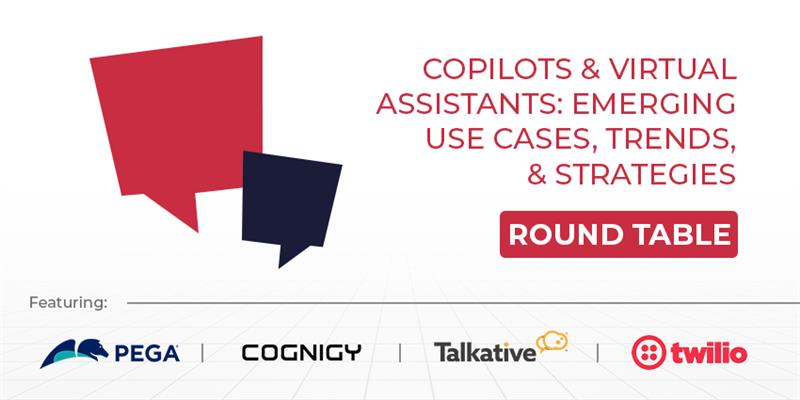Copilots and virtual assistants are continuing to drive efficiency across customer-facing teams.
In doing so, they are drafting customer responses in service, automating lead-gen initiatives in sales, supporting copy generation in marketing, and so much more.
However, with generative AI still early into its hype cycle, what comes next for copilots and virtual assistants?
In this roundtable, our panelists answer that question. They include:
- Felix Winstone, Co-Founder & CEO at Talkative
- Sebastian Glock, Director of Product Marketing at Cognigy
- Peter van der Putten, Director of the AI Lab at Pegasystems
- Sam Richardson, Executive Engagement Director, EMEA & APJ at Twilio
Below, each participant shares emerging use cases for copilots and virtual assistants, trends for 2025, and best practices for deploying them.
Emerging Use Cases for Copilots & Virtual Assistants
Supervisor Copilots
Winstone: Today, we think of CX copilots as primarily agent-facing. An emerging use case in 2025 will be supervisor copilots.
These copilots can expedite and eventually automate the functions of the classic contact center supervisor role.
Rather than having supervisors sift through countless transcripts and calls, the AI will detect anomalies in real-time, surfacing issues only when human oversight is truly needed.
They will also deliver far richer reporting by synthesizing large volumes of data – for example, summarizing thousands of transcripts to reveal trends instantly.
Beyond real-time supervision and reporting, supervisor copilots enhance knowledge bases, facilitate AI training and feedback loops, and support compliance monitoring.
In doing so, they free supervisors to focus on strategic improvements that ultimately drive better customer experiences.
Personalized Outbound Calling
Glock: A breakthrough use case for AI Agents in 2025 is proactive, personalized outbound calling that feels helpful rather than disruptive.
Previous bot generations, relying on NLU-driven, deterministic approaches, struggled to anticipate customer context or sentiment, often leading to generic, poorly-timed calls that frustrate customers.
Agentic AI transforms this by enabling AI Agents to adapt flexibly to each customer’s situation in real time.
For example, when contacting a customer about a contract renewal, the AI Agent can consider recent interactions, service usage, and sentiment to personalize the offer—whether it’s a retention package, upgrade suggestion, or proactive check-in.
With low-latency responses and natural, humanlike voices, these interactions feel smooth and personal, increasing customer trust and acceptance of AI-driven service.
The ability to reason and adapt dynamically makes outbound engagement more effective, turning it into a powerful tool for customer satisfaction and revenue growth.
Research Agents
van der Putten: Generative AI is quickly transforming from a passive service being called once with a simple dynamic prompt to agentic systems that can take actions themselves.
These agents use the power of generative AI to make sense of a user request and translate it into context and goals, understand what tools it has available, and then generate and execute dynamic plans to reach these objectives.
As it is a safe testing ground, the first agents that will be successfully adopted at scale in customer service and experience will be ‘research agents’ who will research a particular issue or question iteratively and, when they conclude, synthesize it into a compact answer.
For instance, Pegasystems has introduced an AI-based ‘intern’ called Iris, who researches various data sources and systems to respond to up to a thousand inbound email requests daily.
Effective IVR
Richardson: In 2025, we’re likely to see further automation of many of the day-to-day functions of contact centers and frequent sales and support activities such as pre-sales conversations, lead qualification, and self-service product assistance.
While self-service channels for customer service are now commonplace, Gartner has found that – despite as many as 70 percent of customers using virtual assistants and other self-service channels to resolve their queries – only around nine percent are successful in fully resolving them purely by these means. As the technology develops, we’re likely to see it become more flexible and adaptable.
According to McKinsey’s research, this will help boost efficiency and save costs. They found that improving the effectiveness of the IVR systems commonly used in contact centers by 5-20 percent can help reduce total call center costs by 10-30 percent within three to six months because customers get the help they need more quickly.
Ultimately, there’s less circling back and a smaller workload for contact center staff to pick up.
Key Copilot & Virtual Assistants Trends
Conversational Knowledge Curation
Winstone: We see a new role as key to the success of copilots: the “Conversational Knowledge Curator.”
Typically, an experienced agent with deep organizational expertise, this individual will manage the data and workflows that copilots consume.
They ensure virtual assistants deliver context-rich, accurate responses by building and maintaining a curated knowledge base encompassing explicit and tacit information.
As contact centers grow increasingly complex, the conversational knowledge curator will coordinate with teams to update and optimize insights, bridging any knowledge gaps that arise.
As organizations scale their use of copilots, this role becomes a linchpin, ensuring virtual assistants remain relevant, compliant, and consistently aligned with business objectives.
We’ll reach a point where human supervisors do one percent of the work, and the AI does 99 percent.
You don’t want it to be 100 percent AI. But you want it to be a human-machine collaboration that continually refines the CX function.
Managing Entire Interactions With AI Agents
Glock: Businesses are moving away from managing multiple disconnected service channels as customer expectations shift toward more straightforward, more unified experiences.
AI Agents can now engage customers consistently across voice, chat, and text, ensuring seamless conversations without forcing customers to repeat themselves or switch channels to get help.
These agents can handle inquiries and service tasks fluidly and in a context-aware manner.
Copilots have played a valuable role in supporting human agents by providing suggestions and retrieving information.
However, as AI Agents gain reasoning capabilities and the ability to act more autonomously, the reliance on copilots diminishes.
Modern AI Agents can now independently manage entire customer interactions, from troubleshooting issues to completing transactions, reducing the need for human intervention while still ensuring complex cases are escalated when necessary.
This shift simplifies service operations and improves both speed and consistency in customer care.
Research Agents Evolve
Van der Putten: Research agents will be the first to spread like wildfire, first for internal users, but quickly open up to external partners and customers once agents and data sources have been tuned appropriately.
Next up will be agents that don’t just take actions such as researching data sources and APIs ‘read-only’ but also take actions that actually change things in the real world, such as changing statuses, services, or products for a customer in back-end systems.
This requires proper instrumentation to understand and govern agent behavior, and the agents themselves will need to understand when to check back with a human agent or customer.
Customer AI Assistants
Richardson: One trend likely to influence this technology’s future is the increasing pressure businesses face to become more agile and data-driven.
They must make decisions more quickly and cater to increasingly discerning and demanding customers.
Future developments could see the traditional form fills that customers are usually asked to complete replaced by AI Assistants, which allows that same data to be gathered through conversations and automatically inputted.
Best Practices for Deploying Copilots and Virtual Assistant
Follow This Approach…
Winstone: Start by mapping out a clear business case, defining success metrics, and aligning the copilot’s capabilities with organizational goals.
Next, develop a robust knowledge base to ensure the virtual assistant provides accurate, efficient responses.

Then, identify a select group of agents – those who are open to new technology and skilled at providing actionable feedback – for the initial rollout.
This pilot cohort will refine deployment strategies, validate performance measures, and highlight improvement opportunities before scaling the solution.
Following this structured, data-driven approach establishes a strong foundation for a copilot or virtual assistant that meets your organization’s needs and delivers measurable value.
Composite AI Setups
Glock: Building LLM-based AI Agents is less like coding software and more like educating a person. Success comes from iterative testing and refining instructions—shaping behavior, not just writing rules.

Knowing when to use agentic AI versus a process-driven approach is a key best practice. Tasks with dynamic decision-making, like proactive customer retention calls, thrive with agentic AI, while structured processes like password resets are best handled with traditional automation.
The real power lies in a composite AI setup – a hybrid model where both approaches work together. Mapping use cases carefully ensures the AI can flex where needed while keeping high-efficiency automation where it fits best.
Structured AI Roles
van der Putten: There are several best practices to consider when deploying agentic systems.
Just like in the real world, think of different agents that take different roles and collaborate with each other.

Each agent should only have access to the tools required to safely do its job. It should also have additional capabilities, such as a memory of successful previous plans and actions in a particular context.
Each agent’s access level should also be controlled depending on its role, but potentially also based on the profile of the agent who made the original request.
Finally, it is important that human end users can ask for a deeper explanation of how a particular collective of agents arrived at their final answer and have the opportunity to provide feedback if they desire.
Connecting Virtual Assistants and CRMs
Richardson: No virtual assistant will ever be helpful without access to the information and value that customers or employees need.

Before rolling out such technologies, businesses need a deep understanding of the common practical tasks that users find themselves needing to complete and what frustrates them most.
This could include finding and tracking shipping information, sizing details, or accessing their online account.
But it’s not just that. Businesses also need to connect their virtual assistants to their CRM and sales database so that they can access everything they need to know about customers and their previous interactions to solve their challenges.
Miss out on our previous CX Today roundtable? Catch up here: Customer Data Platforms: Next-Gen Features, Trends, & Providers







